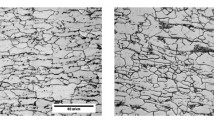Rotary rolling of quenched-and-tempered hypereutectic silumins 01392 and AK18 makes it possible to refine the primary and secondary crystals of silicon and change them from plate to globule form. Adding to similar results obtained previously on hypereutectic silumins 01390 and 01391 that were not quenched and tempered, rotary rolling of quenched-and-tempered hypereutectic silumin AK18 also refines and changes the shape of the excess phase Al9FeNi that is usually present in piston-grade silumins and determines their resistance to heat.
Similar content being viewed by others
References
G. B. Stroganov, V. A. Rotenberg, and G. B. Gershman, Aluminum Alloys with Silicon [in Russian], Metallurgiya, Moscow (1979).
G. I. Eskin and Yu. P. Pimenov, “Obtaining deformed semifinished products of hypereutectic silumins,” Tekhnol. Legkikh Splavov, No. 2, 51–56 (1996).
G. I. Eskin, Ultrasonic Treatment of Light Alloys Melt, Gordon & Breach Publishers, Amsterdam (1998), p. 334.
E. I. Panov, G. I. Eskin, L. B. Ber, et al., “Structural features of bars of hypereutectic silumin 01390 obtained by rotary rolling,” Tekhnol. Legkikh Splavov, No. 5, 43–49 (2004).
G. I. Eskin, D. G. Eskin, Yu. P. Pimenov, et al., Russian Federation Patent No. 2092604, C 22 C 21/4, Heterogeneous Aluminum Alloy. From 10.10.1997.
V. K. Afanas'ev and A. N. Prudnikov, “Development of a piston-grade hypereutectic silumin and a technology for making pistons through a shaping operation,” Izv. Vyssh. Ucheb. Zaved. Tsvetn. Met., No. 6, 53–56 (1999).
E. I. Panov, “Research findings on the mechanism of structure formation in hypereutectic silumins and improvement of their ductility in rotary rolling,” in: Promising Technologies for Light and Special Alloys [in Russian], FIZMATLIT, Moscow (2006), pp. 161–179.
S. P. Galkin, I. V. Doronin, A. E. Antoshchenkov, et al., “Use of radial-shear rolling to give ledeburitic steels the structure of naturally strengthened composite materials,” Tekhnol. Metall., No. 4, 6–8 (2007).
Author information
Authors and Affiliations
Additional information
Translated from Metallurg. No. 7, pp. 37–41, July, 2008.
Rights and permissions
About this article
Cite this article
Eskin, G.I., Panov, E.I., Ber, L.B. et al. Effect of the casting and deformation technology on the structure and properties of quenched-and-tempered hypereutectic silumins. Metallurgist 52, 388–394 (2008). https://doi.org/10.1007/s11015-008-9075-2
Published:
Issue Date:
DOI: https://doi.org/10.1007/s11015-008-9075-2




